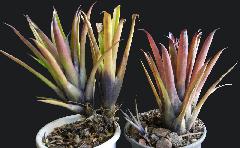
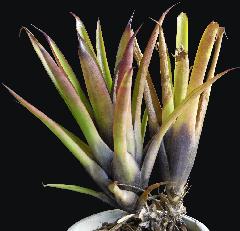
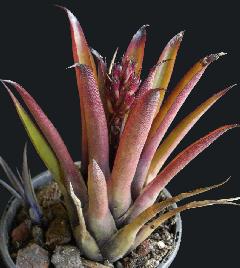
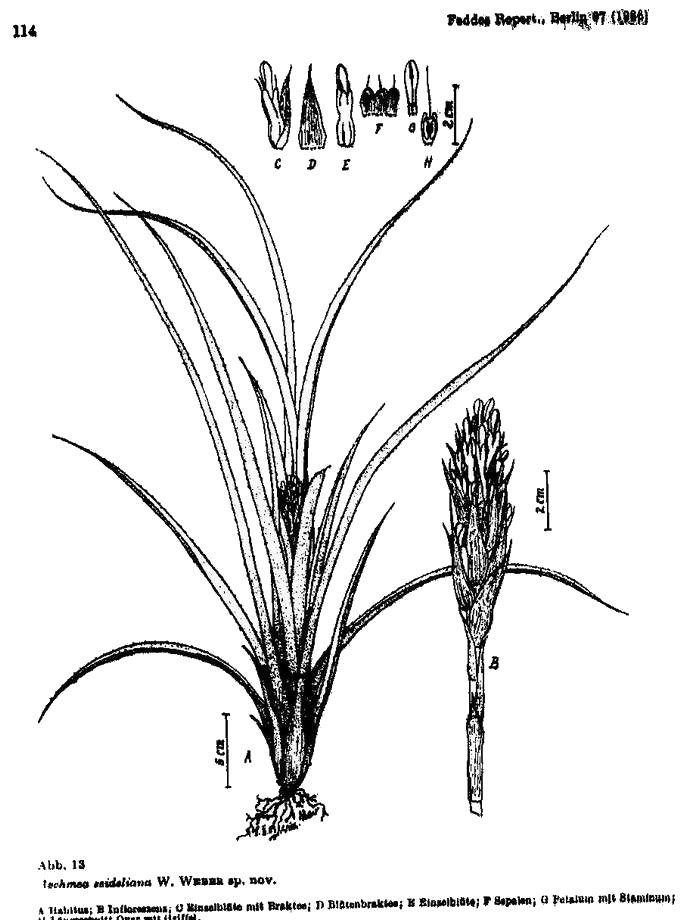
Now moved to seideliana |
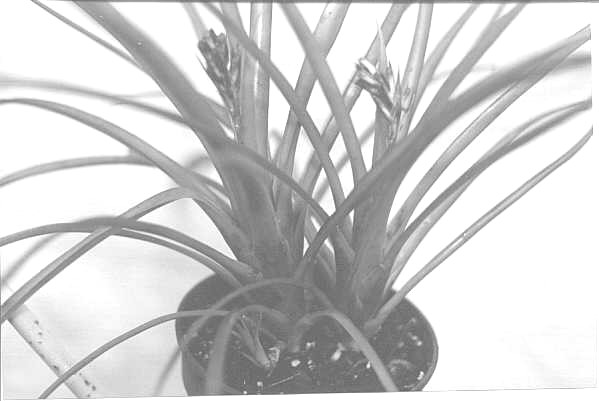
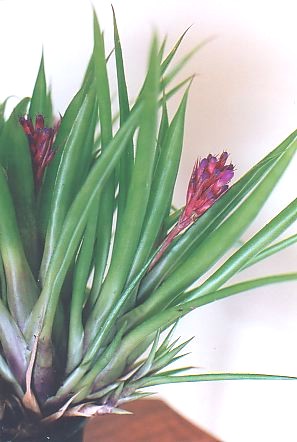
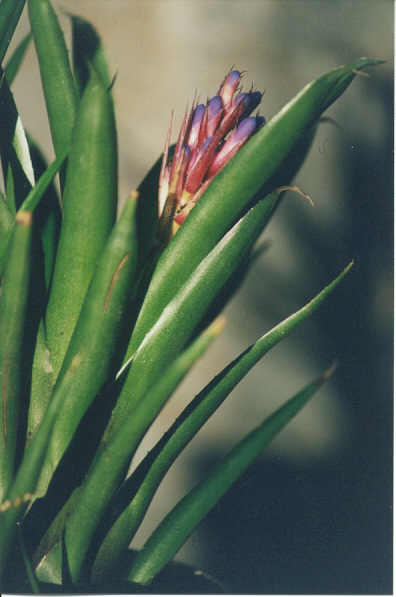
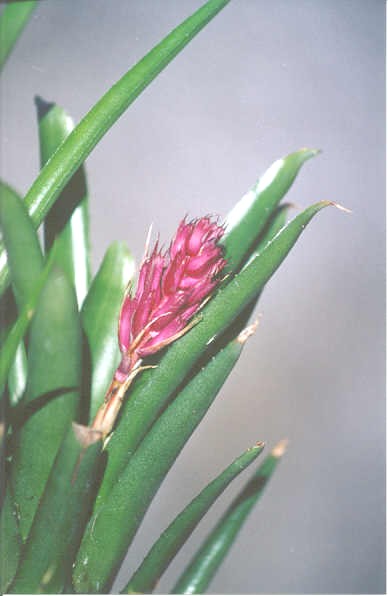
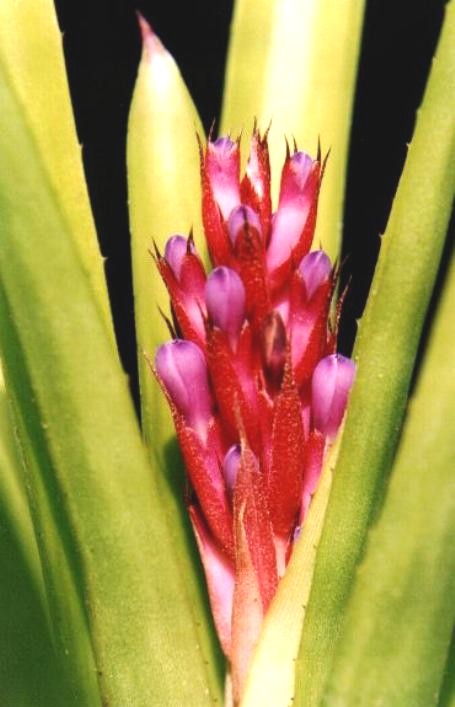
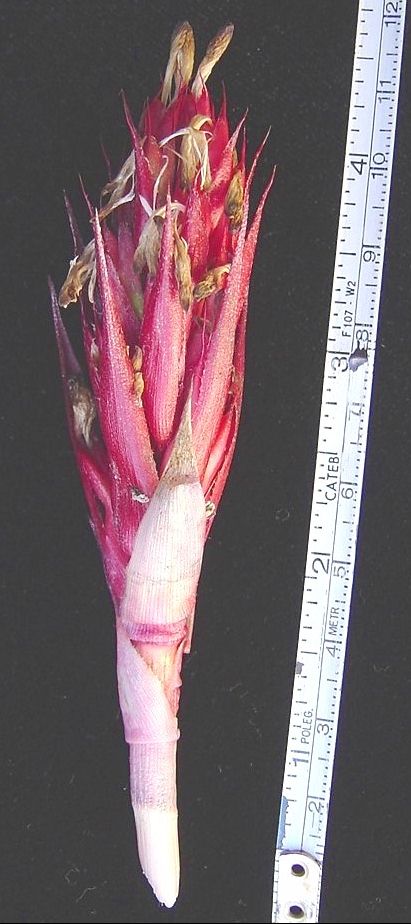
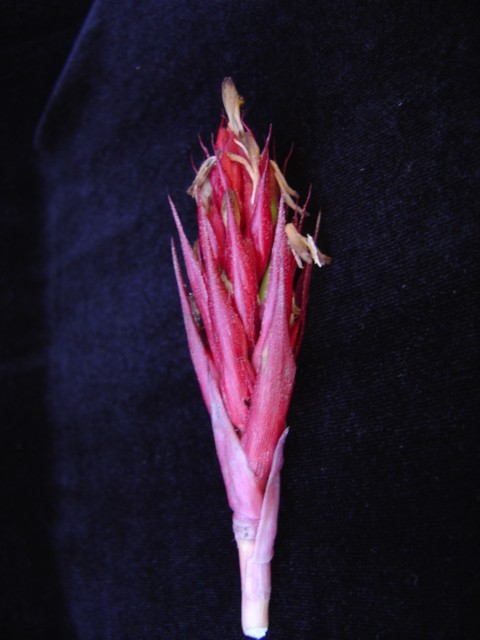
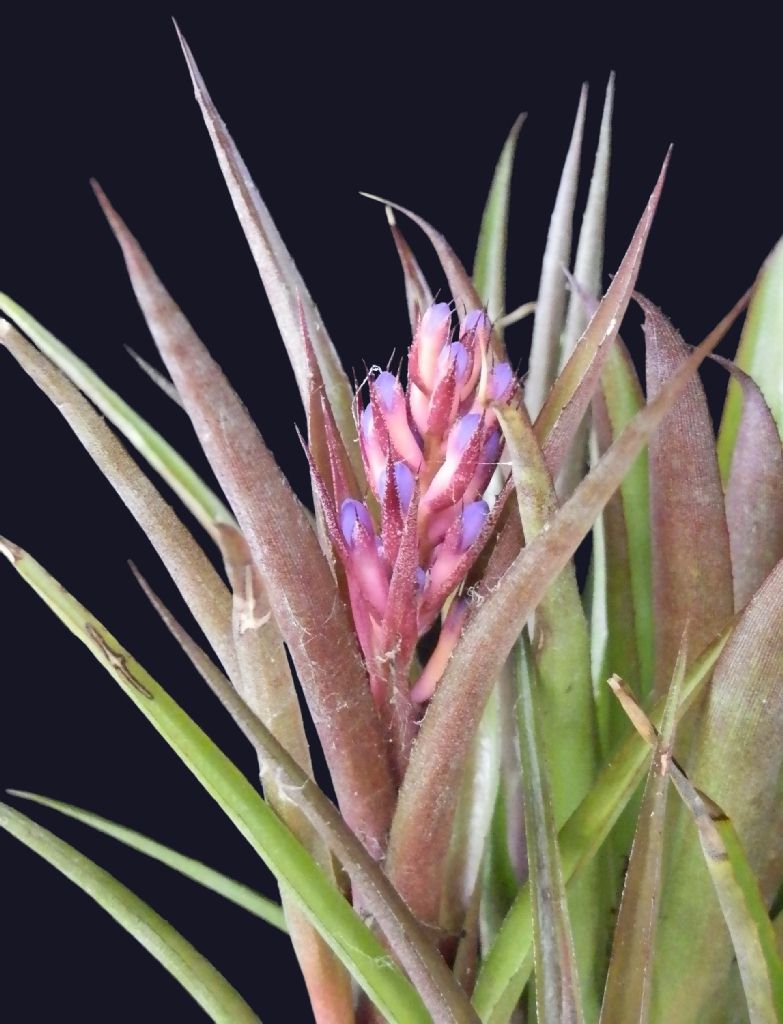
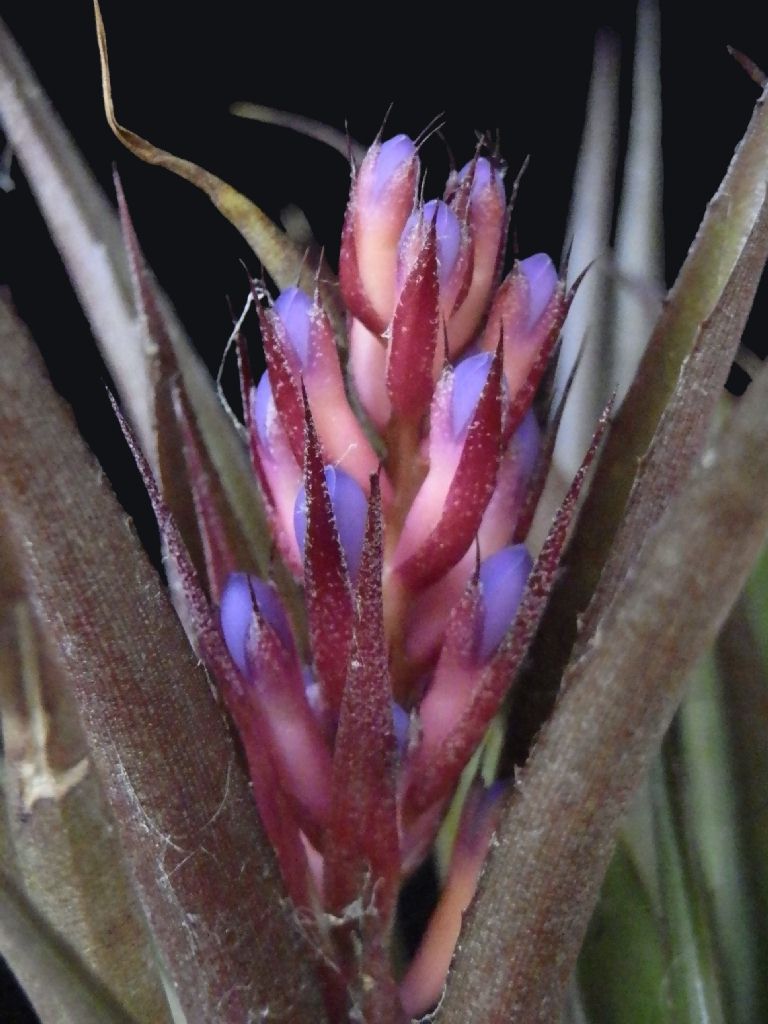
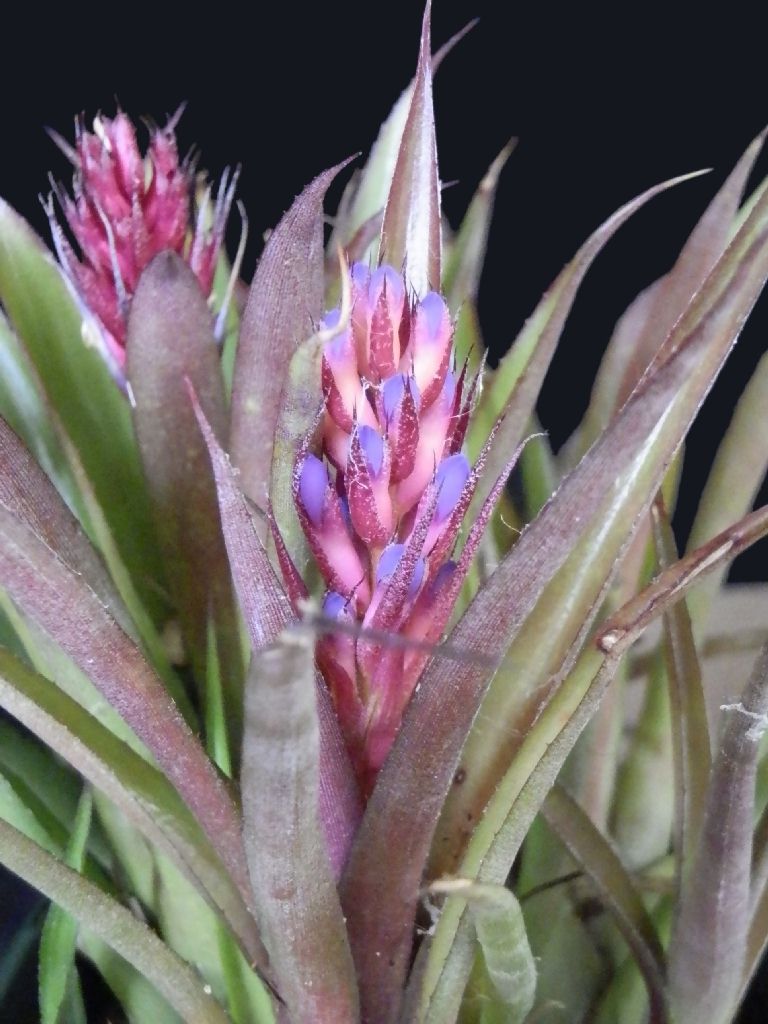
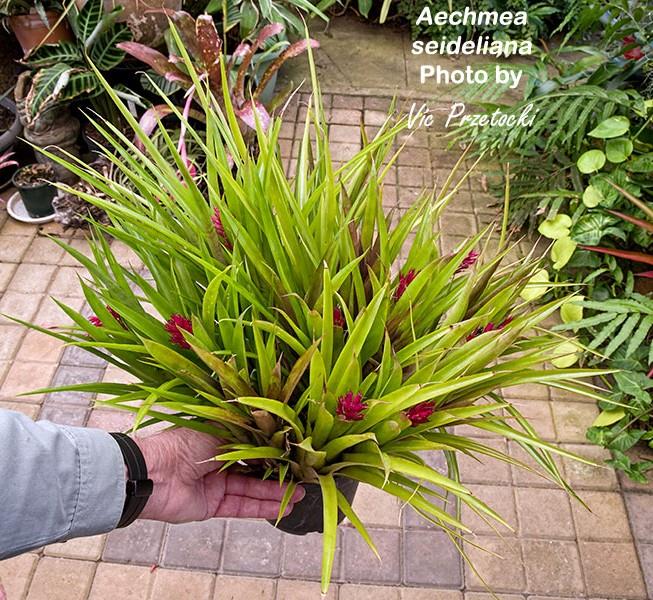
First we should look at the original description duly translated to English, that follows and Weber’s original drawing to give you an idea of what we are worrying about!
Aechmea seideliana Weber, Feddes Repert. 97: 113-5. 1986
Translated from the German by D Butcher
Similar to Aechmea pimenti-velosoi Reitz 1952, but leaves narrower, sepals with a longer mucron and high connate.
Plant flowering to 45cm high, forming a moderately erect rosette much longer than the inflorescence;
Leaf sheath oval, 60mm long, to40mm wide, the base light violet with appressed scales, edges entire;
Leaf blade the outer ones thin linear, with long tips, strongly grooved, to 45cm long, above the sheath 16mm wide, the inner ones to 30mm wide, green, moderately thick scales, edges very fine and not very densely spined;
Scape to 80mm long, round, 5mm diam., not scaled;
Scape bracts erect, longer than the internodes, the bottom ones leaflike, the upper ones triangular-lanceolate and whitish, the edges of the blade with fine spines.
Inflorescence simple, densely polystichous, to 18 flowers, 60mm long, 23mm diam.;
Flower almost sessile, erect, to 30mm long;
Flower bracts triangular-lanceolate, long awl-like, carmine red, membranaceous, to 38mm long, 9mm wide, with white scattered scales, edges with very fine spines, longer than the sepals.
Sepals 14mm long, including a 5mm long mucron, carmine red, joined for 5mm, nerved, not scaled, with weakly asymmetrical membranaceous edges.
Petal longish oval, hood shaped, 19mm long, to 5mm wide, white, with two nectar scales at the base;
Stamen and Style enclosed; Filament thin, 13mm long; Anther 3-cornered, 5mm long, joined at base; Style equally as long as the stamens; Stigma turning spirally;
Ovary weakly three cornered, egg shaped, 11mm high, 5mm diam., whitish carmine red, Epigynal tube very striking.
Type Brazil, Espirito Santo, Domingos Martins, Leg. Alvim Seidel No.864 Holotype WEB661
Let us now look at what has been written in the past.
ONE DOWN AND TWO(? ) TO GO by Derek Butcher Sth. Australia in Bromeletter 29(6): 12-3. 1991
It must have been 3 years ago that I recognised problems with Aechmea roberto-seidelii and Aechmea seideliana and its two varieties rubrafolia and purpurea. It was a challenge I could not resist because I felt that hybrids must be involved somewhere. Those who went to the Sydney Conference would have heard of further updates to the saga but little about conclusions.
I have now decided that the hybrid problems must revolve around Aechmea roberto-seidelii and that any plant with pendant Aechnea warasii flowers on a plant called Aechmea seideliana should have its label stomped on !
I have a strong feeling that Aechmea seideliana is in Australia and is floating around the eastern states under the guise of Guzmea --?--or Aechmea recurvata hybrid. Needless to say, when at the Sydney Conference and seeing Guzmea --?-- on a label was just too much temptation to place upon a fellow such as myself. Now, three months later I have a flower which brought me to think of the Ortgiesia group of Aechmea. With the help of Luther's List (or is it Franklin's Tape) I came across this Aechmea seideliana. I was able to acquire a photocopy of the original description by W. Weber in Feddes Repertoriium 1986 and the drawing as shown here should be of great interest. The description tallies almost exactly, and I do suggest that if we can find how this plant did get to Australia, sufficient material be sent to Harry Luther for official investigation.
The only thing that grates is the blue petal blades compared to whitish in the description. However, this is not as bad as it sounds when you realise that Tillandsia lorentziana description says white petals whereas there is a blue flowered form, and our own Marjory McNamara brought back white flowered Tillandsia reichenbachii despite the official blue/violet!
Weber related this plant to Aechmea pimenti-velosoi, but with much narrower leaves. Whether the true Aechmea pimenti-velosoi is in Australia is another challenge. To confuse matters there is a variegated plant called Aechmea pimenti-velosoi in the eastern states which clearly is NOT and is being closely monitored ( Now ‘Pie in the Sky’). Secondly, many of the Aechmea recurvata hybrids resemble a true Aechmea pimenti-velosoi.
The provisional name of Aechmea recurvata hybrid given to this plant is intriguing in that it is an easy way out. If it is an F1 hybrid then we should be growing self-set seed to prove it. Secondly we must use Bill Morris's philosophy and ask ourselves who was Father. The thin leaves give us a problem and the use of Guzmea --?-- would undoubtedly have been an attempt in trying to solve the problem.
I understand that the plant was grown from seed by Lou Forrest but where did he obtain the seed? I also understand that the Australian Society imported seed from Seidel a few years ago although I have no documented proof. We in South Australia are currently discussing an "odd" plant we obtained from Ruby Ryde also raised from seed and possibly the same vintage. This particular plant has definite links to Aechmea pimento-velosoi and has been referred to Elton Leme for comment. (Now ‘Aussie Ruby’) We will report on progress as details come to hand.
In the meantime,if you are aware of any extra details you may have on the Aechmea seideliana please contact the writer.
MORE ON AECHMEA SEIDELIANA by Peter Franklin, NSW in Bromeletter 30(1): 12-13. 1992
I have to take responsibility for starting Derek Butcher off on the trail of Aechmea seideliana. His interest in this plant came about when he and Margaret visited my home after the Sydney Conference last year, and in looking at my collection, Derek seized upon a plant that I had labelled as --- "Aechmea ? (originally labelled Guzmea)".
Neither of us believed for a moment that the plant was a Guzmea (a bigeneric cross between Aechmea and Guzmania) but it was interesting to speculate as to what the plant might actually be - so a piece found its way to South Australia. The plant soon flowered for Derek and the result of his research was that the plant was very close to Aechmea seideliana described fairly recently by Weber. Derek's article was in the Nov/Dec 1991 Bromeletter.
I had tried several times to key out the plant using Smith and Downs but I was never able to achieve a satisfactory result so I concluded that the plant was either a species not described in Smith and Downs or was a hybrid with an Ortgiesia parentage. I was very pleased, then, when Derek came up with the A. seideliana name - one that is not listed in Smith and Downs.
I originally purchased the plant from Lou Forrest in Oct 1987 and it was one of my first purchases. He said that a woman in Sydney had crossed an Aechmea with a Guzmania to produce this plant and so he sold it to me as a Guzmea - but he was quite sceptical that it was anything other than an Aechmea. I didn't know any better at the time so I went along with what he said.
Soon after that I joined the Hunter District Society and there I found that the plant has quite a wide distribution amongst the members. Their plants however, are called Aechmea recurvata hybrid, or Ae. recurvata x gamosepala or just Aechmea ?. I suspect that these names were applied to the plant in an effort to give it a name consistent with its appearance, rather than there being any real evidence of it being a hybrid.
In Dec 1988, my plant set seed. This I collected and grew on, and now the remaining seedlings are approximately two inches high. Of course, I don't know whether these seed-lings are selfed or whether they had some other pollen donor, but the interesting observation that I can make is that all the seedlings in the batch look the same, and they all look remarkably like the mother plant. I tend to believe now that the "Guzmea" is an Aechmea species and that it is occasionally self fertile given the right conditions or perhaps given some stimulus from stray pollen. This occasional self-fertility may explain why the person thought that she had been successful with a cross of an Aechmea with a Guzmania. It will be a couple of years yet, though, before the seedlings show their true identity. (At 2006, Peter reports that nothing startling could have happened because he cannot remember what happened to said seedlings, so alas, we are back to step1!)
In the last day or so, the story has had a new player added to the cast. Now a plant labelled as Nidularium microps var bicense is involved. This plant seems to have been imported from New Zealand at some time (or so the label indicates) and has passed through several hands before arriving at Bill Morris'. Bill was attracted to the plant because it seemed different to his other Nid. microps plants. And it was different! The plant flowered for Bill and it was obvious to him that it was not a Nidularium at all, but same sort of Aechmea from the Ortgiesia group. On inspection, this plant has red leaves but otherwise would appear to be the same plant as my "Guzmea", at least in vegetative form (without the benefit of a flower on either). This red Nidularium could easily turn out to be another form of Aechmea seideliana.
I am told that there are other plants with wider Leaves labelled as Aechmea seideliana in a few collections in Australia and at least one of these has been identified by Elton Leme as Ae. seideliana.
To cloud the issue even further, there is yet another candidate. I have a half sized version of the "Guzmea" with the same flowers as the larger one but only half as many of them and with the leaves half the length and half the width. This small one is grown side by side with the larger, so I doubt whether the difference can be attributed to environmental conditions alone. ..... That makes at least 4 potential Ae. seideliana’s.
What remains to be done now to solve this dilemma is to grow the "Guzmea" large, the "Guzmea" small, the "Nidularium", the selfed seedlings and the already identified Ae. seideliana in similar conditions, to compare the inflorescences and to eventually have Harry Luther pass comment on them. Hopefully this will put to rest another "identity problem" in bromeliad naming in Australia and perhaps New Zealand.
In the 1980’s I received a plant under this name from Marj McNamara and when it flowered I dissected it to try to link to the protologue. The only difference was blue petals instead of white. I saw no reason to change the name even though there were name problems with plants coming out of Seidel nurseries. In this case we do not know the source of Marj’s plant in Brazil. Was it a seed pod?
This year Vic Przetocki in WA flowered his "Aechmea seideliana" and queried why it had blue petals instead of white. Because we look at cultivars somewhat differently these days it has been decided that it is better to give this plant the cultivar name ‘Seidel Blue’ so its story can be told. Not only does it refer to the colour of the petals but a mistake in identity.
If we read Aechmea ‘Aussie Ruby’ by Derek Butcher in Bromeletter 33(4):13. 1995 we will see we had two problems which we tried to solve by using a cultivar name and a species name of A. seideliana. In hindsight it was a wrong decision because we knew nothing about the origins of the species plant or where it had been found in the wild.
To save you checking this reference, details follow
Aechmea ‘Aussie Ruby’ by Derek Butcher in Bromeletter 33(4):13. 1995
"Now to the second part which also revolves around Ruby Ryde. Those of you who have Baensch's 'Blooming Bromeliads' would have immediately noticed the mistake on page 69 where an alleged Aechmea seideliana is pictured. Those who read 'Bromeletter' will know that the 'true' plant is in Australia, albeit with bluish red petals compared to white in the original description. The illustrated plant is a vigorous form of A. warasii. Oh, by the way, I sent Baench copies of Weber's original description, original drawing and a coloured photo of OUR plant just for their information. It would appear that some do not read 'Bromeletter'!
Back to Ruby who had a plant also raised from seed allegedly from Seidel which was more robust than the Aechmea seideliana and had a large inflorescence. This plant raised the temperature in Adelaide with yours truly saying it was a hybrid and Len Colgan maintaining it was a species. Eventually Len could stand it no longer and six months ago sent pieces to Elton Leme in Brazil. Both of us were on edge until a letter arrived just before I started dissecting the aforementioned Wittrockia, which is another reason why it is in this article! Elton had never seen such a plant and could only assume it was a hybrid. However, seed raising from this plant has produced fairly consistent progeny. In the meantime, I believe it should be given a Cultivar name because it is distinct, it is an attractive plant, and what better name than Aechmea 'Ruby'. (Now called ‘Aussie Ruby’ because there is already a ‘Ruby’ in existence in the USA). This will identify the plant and also indicate its source for future reference.
I am enclosing a line drawing of A. seideliana which seems related to A. pimenti-velosoi to remind you of the plant that should have been in Baensch' s book. It will also give you an idea of the form of Aechmea 'Ruby' which is a large form. The leaves are longer and wider. The inflorescence is 10cm long and 5cm diameter compared to 6cm and 2cm. It is 60 flowered compared to up to 20. The ovary and base of the sepal yellow compared to whitish pink. The top portion of the sepal still carmine red and petals bluish red."
There are similar plants being grown in Australia where one main difference is that A. ‘Seidel Blue’ has reddish ovaries and A. ‘Aussie Ruby’ has yellowish ovaries. Plants are in cultivation that are in between which suggests that they are in a grex and it is up to you to see where you think they may fit.
Derek Butcher's original dissection notes.
Concluding "aff A. seideliana, close except for blue petals".
Plant. 25cm high x 30cm wide, numerous leaves, stolon 2cm long.
Leaf Sheath. oblong, 6cm long x 2.6cm wide. Lepidote scattered brownish appressed scales, green & purple, entire.
Leaf blade. ligulate, green, 16cm x 1.8cm, tip bent back purplish.
Scape. 16cm x 7cm thick, internodes ~1cm apart.
Stem bract, sheath. 3cm x 1cm, white, adjacent, not keeled, toothed, purplish tip.
Spike. cylindrical, 7cm long x 2cm wide, ~24 flowers, redish, flowers from middle.
Rhachis. red, wooly.
Floral bract. 3.3cm x 8mm, lepidote white woolly heavily more on underside, not keeled, nerved, pinkish.
Flower. erect, 2cm x 4mm, no stem.
Sepal. 1cm x 3mm including 2mm mucrose, slightly asymetric, sparse wooly on outside, deep red, not keeled, nerved on inside.
Petals. hooded, blue upper hood 6mm wide on white base 3mm wide, 1.5cm total length with fimbricate petal appendages 2mm up.
Filament. 2mm + 7mm free, white
Anther. 3-angled, 4mm long, joined mid at back, blueish
Pollen. white
Pistil. convolute spiral, white
Ovary. 6mm long, white